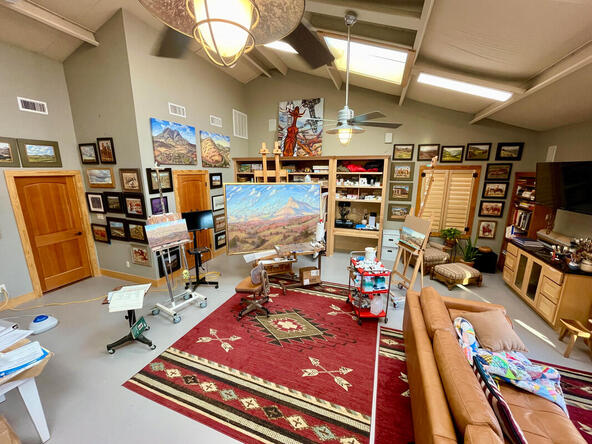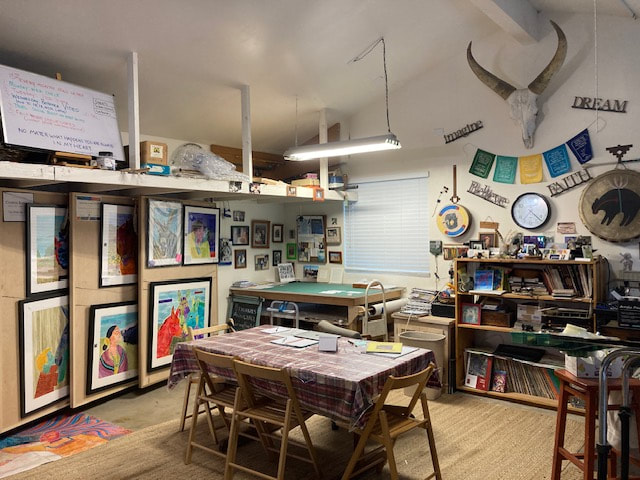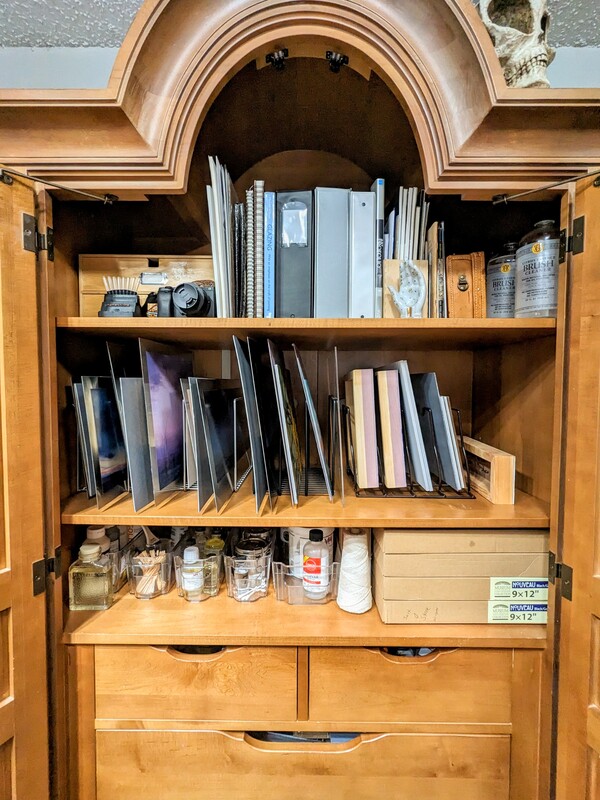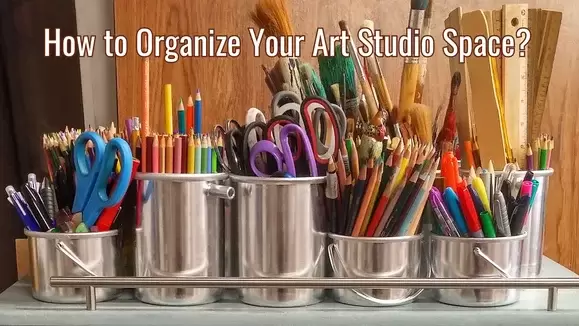|
Artists wear many hats and often have to complete various tasks outside of making art. This ranges from filing taxes to posting on social media, staying on top of art show applications, and more. With such diverse responsibilities, it becomes increasingly important for artists to stay organized. There are 2 important areas we will concentrate on:
1. Organizing your art studio space 2. Organizing your time and schedule This blog will discuss how to organize art studio space and its benefits. Next month, we will talk about how to organize your time and schedule so you don’t miss opportunities and deadlines and can run your art business more efficiently. How To Organize Art Studio Space?As an artist, having a well-organized art studio space is essential for nurturing your creativity and maximizing your artistic potential. We will guide you through the process of creating an art studio that is not only functional but also tailored to your unique needs and artistic style. From setting up your workspace to optimizing storage solutions, we'll share practical tips, innovative ideas, and expert advice to help you transform your art studio into a haven of inspiration and productivity. So, let's roll up our sleeves, tap into our creative energy, and embark on a journey to master organizing your art studio space! Organizing your art studio space can seem like a daunting task, but with the right approach and mindset, it can be an enjoyable and rewarding experience. Here’s a practical, 8-step guide to walk you through the process. Also Read- Why Is Goal Setting So Important For Artists? How To Set And Stay Organized With Your Artistic Goals?
1. Assess your space: Take a good look at your art studio and evaluate the available space. Consider the layout, natural lighting, and any limitations or challenges you might face. This assessment will help you make informed decisions about how to optimize the space effectively.
2. Define your zones: Divide your studio into specific zones based on the different activities you engage in as an artist. This could include areas for painting, drawing, sculpting, digital work, storage, and a dedicated workspace for administrative tasks. Clearly defining these zones will help you maintain order and focus. 3. Clear the clutter: Before you begin organizing, declutter your art studio. Sort through your supplies, materials, and artwork, and get rid of anything you no longer need or use. Donate or sell items that are in good condition but no longer serve your artistic practice. This step will create more space and make it easier to organize your essentials. 
What does Alice Leese ( @aliceleese) say about her art Studio? - “It is my main easel and one on either side so work can be done on three paintings at once, all easels and equipment are on wheels so the setup can be changed easily. The large painting on the main easel is being worked in the frame, didn’t have anywhere to store the frame so went ahead and put it on when the painting was in the final stages.” www.aliceleese.com
(Pro Artist Tip: Clutter in our physical space can create clutter in our head and ultimately put a damper on our creativity and productivity. Ask yourself, do I need this? If I might need it someday would it be easy to buy it later? Is this taking up valuable space in my studio and my head? 4. Optimize storage solutions: Invest in storage solutions that are functional and suit your artistic needs. Consider open shelves, cabinets, drawers, or storage bins to keep your supplies and materials organized and easily accessible. Label containers and shelves for quick identification, ensuring everything has a designated place. The best storage solutions will vary from artist to artist. Think through your particular work habits and flow. What type of storage would help you be more efficient and would be easy to use and stick to using? Artist Pro Tip: Save your receipts and chat with your accountant or CPA about if you can write off these expenses! 5. Create an efficient workspace: Set up your workspace in a way that promotes productivity and inspiration. Arrange your easel, desk, or work table in a position that maximizes natural light and minimizes distractions. Keep your most frequently used tools within reach and organize them in a way that works best for you. Ensure that you do not create a system that hampers your flow, feels unintuitive, or has any barriers to use. 
What Charisse Rudolph (@CharisseRudolph), say about her art studio? “I love my studio even when I’m not working on a painting. I have great lighting, it’s easy to access, I have enclosed, metal storage Cabinets with shelves. There is a back door that leads to my zen garden. In addition, my music is ready to go!”
6. Establish a system for materials: Categorize and organize your art materials based on type, size, or frequency of use. Use clear containers or organizers to keep everything visible and easily accessible. Consider using wall-mounted or pegboard storage for frequently used tools or brushes, keeping them within arm's reach. Over-the-door shoe organizers can be a great (and cheap) tool for organizing assorted materials or supplies.
7. Prioritize safety: Ensure your art studio is a safe environment. Store hazardous materials properly, following safety guidelines. Install proper ventilation if needed and have a first aid kit readily available. Organize cords and cables to prevent tripping hazards and keep fire safety in mind. 8. Maintain organization: Once you've organized your art studio, make it a habit to maintain order. Clean up after each session, return materials to their designated places, and regularly reassess and declutter to avoid accumulating unnecessary items. Also Read- How To Be Productive When Working From Your Home Art Studio 7 Benefits of Staying Organized in an Art Studio1. Increased Efficiency: An organized studio allows you to work more efficiently. When art supplies, tools, and materials are arranged logically, you can easily locate what you need, saving time and reducing frustration. This streamlined workflow enables you to focus more on creating art rather than searching for misplaced items. 2. Improved Productivity: A clutter-free studio space helps clear the mind and enhances productivity. When the physical environment is organized, you can better concentrate on your work without unnecessary distractions. This leads to increased focus, creativity, and overall productivity. 3. Enhanced Creativity: Organized studio space can have a positive impact on your creativity. A clean and well-arranged environment fosters a sense of calm and inspiration, allowing you to fully immerse yourself in your work. It creates a space where ideas can flow freely and you can explore new techniques and concepts without feeling overwhelmed by the disorder. 4. Safety and Accessibility: Organizing an art studio includes ensuring the safety and accessibility of materials. By properly storing hazardous materials, such as chemicals or sharp tools, you can prevent accidents and injuries. Additionally, organizing materials in a way that is easily accessible minimizes the risk of damage and promotes a smooth workflow. 5. Effective Inventory Management: An organized studio space enables you to keep track of your inventory more effectively. By having a designated storage system, you can easily assess your art supplies, materials, and finished artwork. This helps you avoid running out of essential materials and ensures you can quickly identify what you have available for upcoming projects or exhibitions. Artist Pro Tip: When you notice you are getting low on a supply add it to your shopping list, note app, or whiteboard so you don’t have to go through your supplies later to remember what you need to get.
6. Professional Presentation:
As an artist, you may welcome clients or visitors into your studio space, and organization is key to presenting yourself professionally. A well-organized studio shows that you take your work seriously, care about your craft, and value your clients' experience. It leaves a positive impression and enhances the overall perception of your professionalism. 7. Mental Clarity and Reduced Stress: An organized art studio space contributes to mental clarity and reduced stress levels. When you have a clean and organized environment, it creates a sense of order and calm. It eliminates the mental burden of clutter and allows you to focus solely on your creative process. This sense of peace and tranquility in the studio can have a positive impact on your mental well-being. 
Pro-tip by Kerri S. Menchaca (Texas-based oil painter specializing in Contemporary Realism): Being hyper-organized is second nature to me at this point. With two jobs, two kids, and two active pups I need everything easily accessible and ready to go. All of my paints are tucked nicely into this vintage lingerie cabinet, stored cap-side down on board separators I made myself (to prevent oil separation). Papers, books, and small artworks are stored in my mother's china hutch separated by cookie sheet organizers. And my favorite piece is this old atlas case where I store larger pieces.
A note on artists who “thrive on mess” or prefer “organized chaos.”
It’s not uncommon for an artist to feel that they do better in a studio where they can see all their supplies spread out, and they are surrounded by objects that they love to look at. If that is truly how you do your best work- more power to you- do what works for you. However, many artists just need help learning how to be organized, and once they find an organizational system that works for them they find that they do much better. Be honest with yourself if you could benefit from an organizational strategy. A few signs that could be you:
*Missing deadlines is not uncommon. *You have no plan for your career growth. *You are constantly rushing at the last minute to get things done. *You miss opportunities that would have been good for you. *You have multiples of the same supply. *You feel stressed because you are always struggling to find things. *You constantly misplace things. ConclusionStaying organized in an art studio space provides numerous benefits for artists. From increased efficiency and productivity to enhanced creativity and a professional image, an organized studio space sets the stage for a successful and enjoyable art practice. By investing time and effort into organizing your art studio, you create an environment that supports and nurtures your artistic journey. So, take the initiative to declutter, arrange supplies systematically, and maintain a clean and inspiring studio space. Your art and creative process will thank you for it. Remember, organizing your art studio is a personal journey, and what works for one artist may not work for another. Tailor your organization methods to suit your artistic style and workflow. Experiment, adapt, and refine your setup as needed. With dedication and a well-organized art studio space, you'll create an environment that fosters creativity, productivity, and artistic growth.
0 Comments
|
Archives
March 2024
Categories
All
|

 RSS Feed
RSS Feed